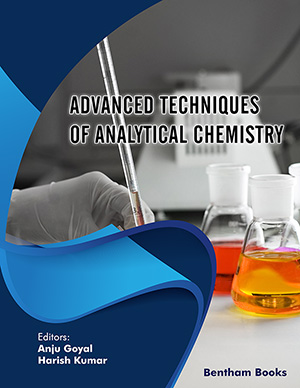Abstract
Background: Developed and validated a new reverse phase high-performance liquid chromatographic (RP-HPLC) method, and it is prompt, precise, sensitive and robust for the estimation of eugenol in seed powder extract of Myristica fragrans.
Objective: The chemometric approach was utilized to obtain a rugged and definitive chromatographic method for the purpose.
Methods: Method variables such as acetonitrile (%) and flow rate were investigated for robustness and optimization by using a face-centered cubic design (FCCD). The Design Expert 12.0.1.0 software has been employed for this optimization. Further, the effects of factors were monitored on the concentrations of eugenol recovered from seed powder extract. Chromatograms have been developed by using an optimized mobile phase mixture containing methanol-water-acetonitrile (10:40:50, v/v/v) and Symmetry® C18 column (5 μm, 3.9 ×150 mm). The mobile phase was derived at a flow rate of 1 mL/min, and estimation of eugenol was performed at ʎmax 272 nm.
Results: Validation of the method has been carried out to reveal its selectivity, linearity, precision, accuracy, LOD, and LOQ. Linear calibration plot for eugenol was held over the concentration across 6.25 and 100 μg/mL (R2 = 0.999). The coefficient of variation was less than 1%, and accurate recovery of eugenol was observed between 96.80 and 99.56%. The LOD and LOQ have been established to be 1.97 and 6.25 μg/mL, respectively. Intraday and Inter-day coefficients of variation have 1.81-1.91 and 1.92-1.57, respectively. Antioxidant activity (AA) by DPPH assay of seed powder extract in five different solvents was performed, and % AA activity was calculated against ascorbic acid.
Conclusion: The validated method has founded to be highly robust and will be applied for the analysis of eugenol's formulation. The highest % AA has reported in hexane solvent.
[http://dx.doi.org/10.1093/clinchem/32.9.1702] [PMID: 3527476]
[http://dx.doi.org/10.1039/C3AY41562G]
[http://dx.doi.org/10.1208/s12248-014-9598-3] [PMID: 24854893]
[http://dx.doi.org/10.4103/2230-973X.187350] [PMID: 27606256]
[http://dx.doi.org/10.1080/08982104.2020.1849279] [PMID: 33183121]
[http://dx.doi.org/10.22146/ijc.21541]
[http://dx.doi.org/10.1016/j.intimp.2010.12.020] [PMID: 21237301]
[http://dx.doi.org/10.2174/1568026621666210701141433] [PMID: 34218781]
[http://dx.doi.org/10.1039/C7RA04803C]
[http://dx.doi.org/10.1007/s13197-014-1573-6] [PMID: 26243914]
[http://dx.doi.org/10.1016/j.indcrop.2015.09.071]
[http://dx.doi.org/10.4103/2229-4708.84436] [PMID: 23781433]
[http://dx.doi.org/10.1016/j.jpba.2006.11.037] [PMID: 17207601]
[http://dx.doi.org/10.1016/j.jpba.2007.12.033] [PMID: 18304770]
[http://dx.doi.org/10.1093/jaoac/93.6.1806] [PMID: 21313806]
[http://dx.doi.org/10.4103/2229-5186.108797]
[http://dx.doi.org/10.3390/molecules18022328] [PMID: 23429347]
[http://dx.doi.org/10.1186/s41120-021-00037-y]
[http://dx.doi.org/10.1021/acs.oprd.9b00238]
[http://dx.doi.org/10.1155/2013/795178]
[http://dx.doi.org/10.1016/j.jchromb.2020.122300] [PMID: 32771967]
[PMID: 30151245]
[http://dx.doi.org/10.1186/s12874-017-0452-z] [PMID: 29233133]
[http://dx.doi.org/10.3390/molecules26154681] [PMID: 34361834]
[http://dx.doi.org/10.1155/2014/869120]
[http://dx.doi.org/10.1590/S0103-64402012000100004] [PMID: 22460310]
[http://dx.doi.org/10.1002/ptr.687] [PMID: 11268111]






















